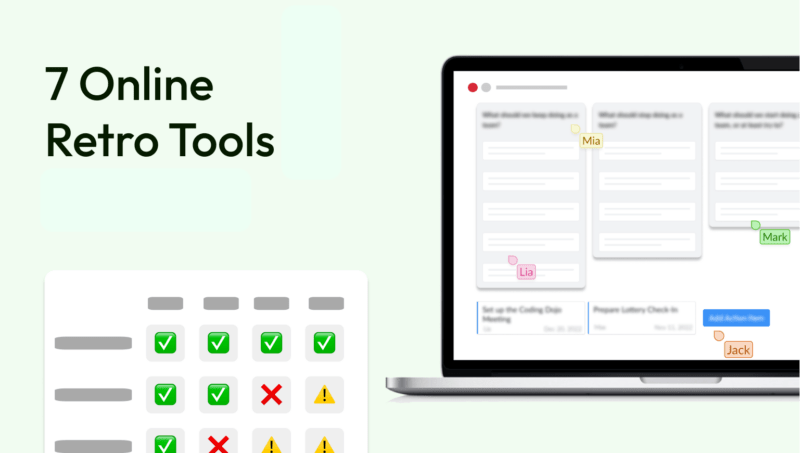As a team lead, you take on a lot of responsibility for your employees and your team. This checklist for team leads will make it easier for you to keep an overview and ensure that nothing goes wrong.
Our template is suitable as a reference for old hands as well as for new team leads. In particular, team leads who are new to their team can use the list as a basis to make a great first impression on the team – regardless of whether you work according to Scrum, Agile or waterfall.
By the way, if you are interested, you can also download the checklist as a manager as a free PDF below. Let's get started!
Checklist for Team Leads #1: The common team goal
If several people only work in parallel but do not have a common goal, this is referred to as a working group – not a team. A working group only becomes a team when they are also working towards a common goal.
Your task as team leader is to understand the team goal in the overall context of the company as quickly as possible. Next, you should make sure that every Direct Report understands the current goal and that there is agreement within the team. If not, it may also be useful to question the goal.
Depending on the context, the team goal can be a specific project goal or relate to certain key figures (e.g. new customers or customer satisfaction) that are important for the company.
Once you have ticked this off your checklist, we come to the second point, which is closely linked to it.
Checklist for Team Leads #2: Building relationships – 1-on-1 meetings
Through regular one-on-one meetings, you strengthen your personal relationship with all team members and create a space for bi-directional feedback. It doesn't matter whether these are held digitally or virtually remotely or on site in person
Especially at the beginning, one-to-one meetings are worth their weight in gold to get to know each other, build trust and create the right expectations. One-to-one meetings also help to implement the team goal and many other points on this checklist, for example.
For new direct reports, or if you are new to the team as a manager, you should initially set the frequency to weekly or fortnightly. Later on, or with experienced employees, fortnightly or monthly is often sufficient as the frequency for one-to-one meetings. Here are 5 tips for the first one-to-one with new employeesand Here are 6 general tips for successful 1-to-1 conversations.
Our Echometer tool also helps to conduct productive 1-to-1 meetings. Here is an example template that managers can use to develop their employees in a targeted manner. We have many more psychologically based templates in our tool:
No small talk, no awkward pauses. 🥱 This 1:1 template simply always works.
- What achievement are you proud of that I may not have noticed?
- What small change would immediately improve your work?
- What would you like to take more time for at work?
...
Checklist for Team Leads #3: Delegating responsibility
The role of team leader can be overwhelming, especially if you try to do everything yourself. But that is not the purpose of the role. As a team lead, you have to learn to delegate responsibility.
Empower your team to make as many decisions as possible themselves. Give team members the confidence to take on certain responsibilities and make it clear that your goal is to build a self-organized team – not one that is maximally dependent on you as the manager.
Here too, it is important to hold one-to-one meetings to understand how the roles in the team are already distributed and which team members already have expertise in which areas. Based on this, responsibility can be given to team members on an experimental basis, especially at the beginning while you are still learning the ropes. Perhaps these team members can even take on the tasks permanently so that you can focus on strategic topics?
Checklist for Team Leads #4: Actively obtain feedback
Of course, not everything will always run perfectly in the team. Be open to Direct Reports giving you feedback or simply sharing their opinion.
Some team members will be more willing to talk about this. For others, you need to create the space for feedback and actively ask for it. Use your 1-on-1 meetings to actively ask for feedback and the employee's perspective again and again.
Incidentally, feedback is not about agreeing with all feedback and trying to implement it one-to-one. Rather, it is about showing employees that you are interested in their opinion and are listening to them. Whether you agree with the feedback as a team leader and how you deal with it is a different question.
Your most important goal as a new leader at the beginning is to understand how team members perceive your initiatives as a leader – compared to the status quo before you – in order to actively manage expectations here as well.
Checklist for Team Leads #5: Create clear role expectations
Does every Direct Report know what is expected of him or her?
Only those who know and understand the expectations of their own role can fulfill them. Creating clear role expectations is therefore always one of the first steps as a manager. Of course, this also includes clearly communicating the demands you place on your employees' performance.
Use your one-to-one meetings to explain the role expectations individually with employees, clarify questions and provide regular feedback on the degree of fulfillment.

Checklist for Team Leads #6: Reflecting on processes in team retrospectives
Team retrospectives are a team meeting format in which the team comes together as a whole for 30 to 90 minutes to reflect on recent collaboration and derive improvement measures. They have become best known through the Scrum framework.
Team retrospectives play a key role in strengthening the team culture and creating an open feedback culture. Especially as a new manager, they can be a fantastic tool for initiating bottom-up changes in the team in a constructive and positive way. You can find more information on agile retrospectives here.
I recommend carrying out retros every two to a maximum of four weeks to make the principle of continuous improvement a habit.
Checklist for Team Leads #7: Promoting a culture of error
Talk about your mistakes yourself! Encourage team members to talk about their mistakes too. You may want to talk about mistakes in the safe space of a one-to-one meeting first, before possibly communicating them to the team.
If the error culture in the team is strong enough, make it a team practice to learn from past mistakes – for example in team retrospectives. Always make sure that this is never about denouncing the guilty party, but celebrating them for owning up to their mistakes and learning from them.
Why is a good error culture so powerful? It is an indicator of how healthy your team is and how safe it feels. Put simply: only when your team is healthy will it freely express ideas. Only then can you become a real high performance team.
"I like this employee, but he's underperforming. How can I address this in 1:1s?"
"I often don't know whether I was too hard – or too soft – in my 1:1s to make a positive impact."
"I can’t identify patterns or trends across my 1:1s. Everything feels isolated."
Checklist for Team Leads #8: Actively designing team routines
Which routines are really needed in the team? Which team meetings currently add little value (even if only for individuals)?
As a team leader, you are primarily responsible for ensuring that your team has effective routines and meetings.
Tip: Use your team retrospectives to question your team routines and meeting formats. This allows your team to take responsibility for helping to shape their own routines and formats. You can find out more about the 5 phases of a retrospective workshop here.
An extreme measure could even be to cancel all meetings for 1 to 2 weeks and take a look: Which meetings do we really need? Yes, we have already successfully tried this internally 🙂
Checklist for Team Leads #9: Addressing conflicts and removing obstacles
If you as a manager don't have the courage to address a conflict openly, no one is likely to do so. The conflict will sap team morale and, in the worst case scenario, you will lose important team members due to the frustration.
As a manager, you must therefore be able to address all conflicts openly – even or especially when they affect you. Your goal is to create a working environment in which the direct reports can perform at their best. However, this is not possible if conflicts cloud everyone's attention.
Incidentally, this is particularly true in virtual or remote teams: here in particular, unspoken conflicts have the potential to contribute to frustration and limit productivity and satisfaction. If you would like a few specific tips on leadership in the home office, take a look here: 5 tips for virtual leadership at a distance.
Checklist for Team Leads #10: Celebrating team successes and highlighting individual contributions
Worthy milestones and goals achieved together with the team. Now more than ever, employees are looking for fulfillment in their work and the feeling of having created something significant. As a manager, you contribute to this by celebrating successes.
Focus primarily on the team's performance, but also highlight individuals if they have made a particular contribution to the result. There should not be a "free-rider effect" where a few people make a disproportionate effort for the team, but in the end everyone takes equal credit.
Praise the special efforts of individuals in front of the entire team so that everyone sees and understands what you value as a team leader (in a healthy and fair way, of course). This serves to appreciate individual achievements, prevents top performers from feeling unappreciated and encourages other team members to also want to qualify for praise in the future. In case of doubt, feedback should first be communicated in a one-to-one conversation. Here is more information on how to give effective feedback.
Checklist for Team Leads #11: Self-management
As a team leader, it is important to plan your own time efficiently by setting priorities and creating fixed time slots for leadership tasks, strategic thinking and personal reflection.
Make sure you keep your stress levels under control by using techniques such as regular breaks, mindfulness or exercise to stay productive in the long term. At best, also actively seek support, be it by exchanging ideas with other managers, obtaining feedback or working with a mentor to continuously develop yourself.
So, hopefully our checklist for managers has given you a good idea of what you need to look out for as a manager. If you are interested, you can download it free of charge as a PDF by clicking on the following link.
Conclusion: The top 10 checklist for Team Leads
Of course, there are countless other things you could or should do as a manager. But if you conscientiously implement the top 10 on this checklist, you are probably already one of the top agile team leads in your company.
If you are still unsure, the digital online software tool Echometer can help you to introduce the most important leadership routines such as agile retrospectives and 1-to-1 meetings with your employees. You can find out more about the Echometer app here.
If you're interested, you can also play around with one of our templates for one-on-one meetings here and try it out with one of your team members free of charge soon:
No small talk, no awkward pauses. 🥱 This 1:1 template simply always works.
- What achievement are you proud of that I may not have noticed?
- What small change would immediately improve your work?
- What would you like to take more time for at work?
...







